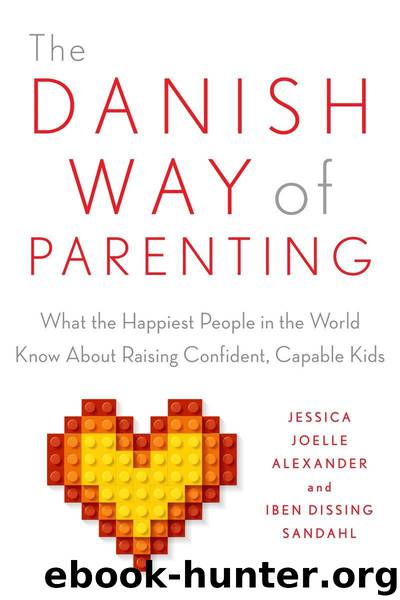The Danish Way of Parenting by Jessica Joelle Alexander

Author:Jessica Joelle Alexander
Language: eng
Format: mobi, azw3, epub
Publisher: Penguin Publishing Group
Published: 2016-06-29T12:11:10+00:00
The Danish Way of Teaching Empathy
One of the first things to consider in terms of teaching empathy is to distinguish between the capacity for empathy and the consequences—that is, how one should put empathy into action in relation to others. This must be learned, and it takes a long time and a lot of good examples from parents and others who are with children on a daily basis.
Let us give you an example. Lisa is playing by the sea with a shovel and Mark, a younger child, wants to play with it, but Lisa refuses. Mark starts crying. What should Lisa do? What many parents would do is give the shovel to Mark because he is crying. But what does this teach? Is it true that we have to always give someone what they want simply because they want it? This is, again, teaching how to do things because there is an extrinsic consequence rather than an internal rationalizing. Lisa plays with the shovel and can sense Mark is getting upset. She needs an adult to help her balance her own needs and limits and then make a decision that she can vouch for and take responsibility for herself. What often happens in these kinds of conflicts is the adults will have compassion for Mark and demand that Lisa carry out the adult’s compassion, forcing her to give Mark the shovel. This is neither fair nor empathic. This doesn’t mean that Lisa shouldn’t learn to take into account others’ feelings—not at all—but what is important is to teach children that parents have empathy and compassion for them as well, understanding how they feel and what their needs are, which will give them the tools to truly use it themselves. It also teaches Mark that he does not necessarily achieve anything by crying.
So what can Lisa’s parent do? After letting the children try to find a solution themselves, Lisa’s mother or father might read her body language and ask her if she wants to share. Perhaps the parent can suggest a deal—Lisa plays with the toy for five more minutes, and then Mark can borrow it, while Lisa starts a new activity. Sharing and playing together is fun—if you’re in the mood for it. It’s OK to say no sometimes, while learning how to share, and enjoy it, is essential too.
In the long term, these kinds of lessons in empathy can be huge. When you teach a child that she won’t be forced to do something simply to appease another or just to make things easier, it becomes a powerful lesson in the long run. Teenagers who are exposed to the wrong kind of peer pressure will have an easier time standing up for what they feel is right if they have been shown that their feelings are valid from early on. If we raise our kids with empathy, they will have a much easier time understanding and practicing it themselves. When their internal compass is strong, it leads them in the right direction.
Download
The Danish Way of Parenting by Jessica Joelle Alexander.azw3
The Danish Way of Parenting by Jessica Joelle Alexander.epub
This site does not store any files on its server. We only index and link to content provided by other sites. Please contact the content providers to delete copyright contents if any and email us, we'll remove relevant links or contents immediately.
| Early Childhood | Parenting Boys |
| Parenting Girls | School-Age Children |
| Single Parents | Teenagers |
The Lost Art of Listening by Michael P. Nichols(7412)
Rich Dad Poor Dad by Robert T. Kiyosaki(6414)
We Need to Talk by Celeste Headlee(5547)
I Love You But I Don't Trust You by Mira Kirshenbaum(3811)
The Complete Idiot's Guide to Coping With Difficult People by Arlene Uhl(3118)
Rich Dad Poor Dad: What The Rich Teach Their Kids About Money - That The Poor And Middle Class Do Not! by Robert T. Kiyosaki(2910)
A Burst of Light by Audre Lorde(2548)
The Book You Wish Your Parents Had Read (and Your Children Will Be Glad That You Did) by Philippa Perry(2456)
Dealing with People You Can't Stand by Dr. Rick Brinkman(2433)
Life Hacks by Dan Marshall(2419)
An Odyssey by Daniel Mendelsohn(2264)
The Expectant Father by Armin A. Brott & Jennifer Ash(2219)
Teach Your Child How to Think by Edward De Bono(2136)
No Time to Say Goodbye(2063)
What I Need by J. Daniels(2030)
The 7 Habits Of Highly Effective Teens by Covey Sean(2026)
The Out-of-Sync Child by Carol Stock Kranowitz(2023)
I Don't Belong to You by Keke Palmer(1957)
The Self-Driven Child by William Stixrud PhD & Ned Johnson(1923)
